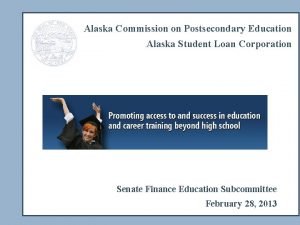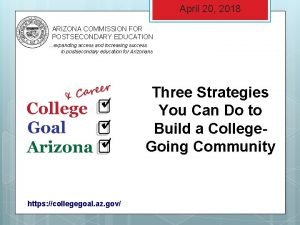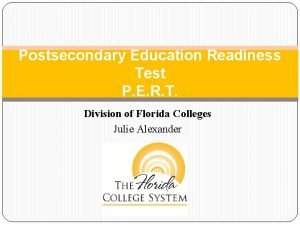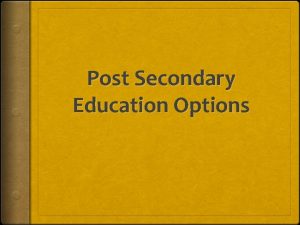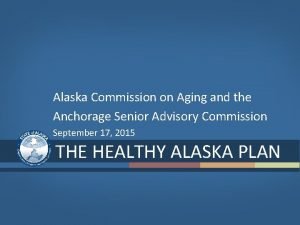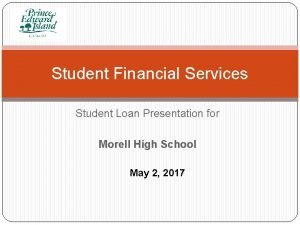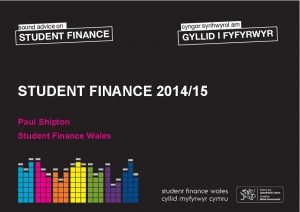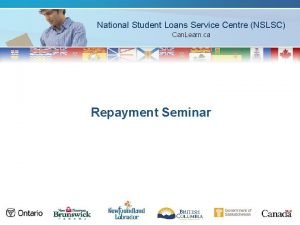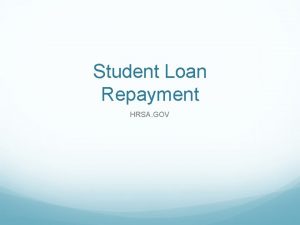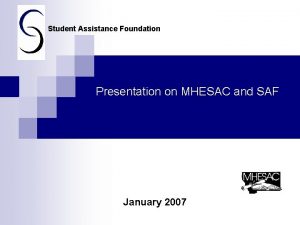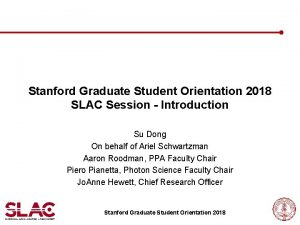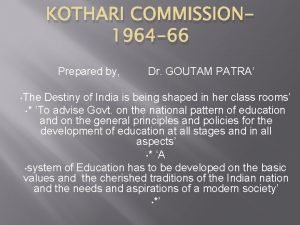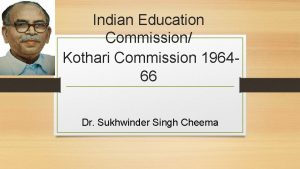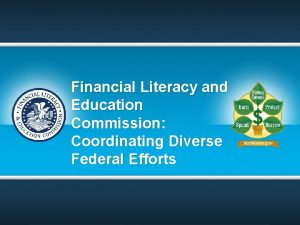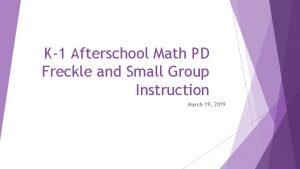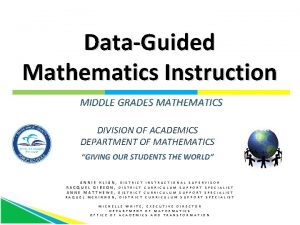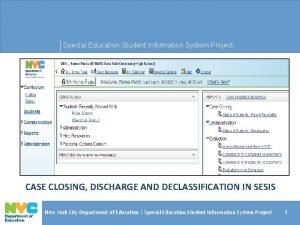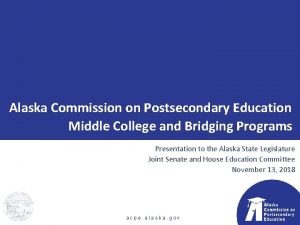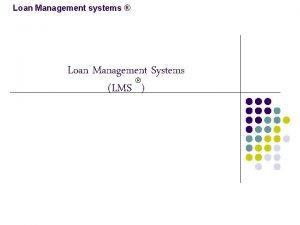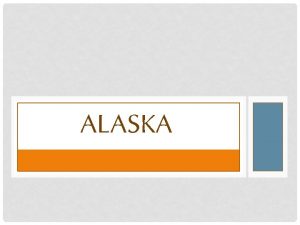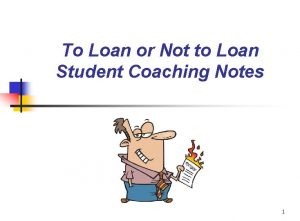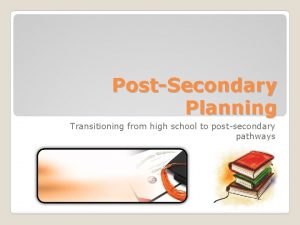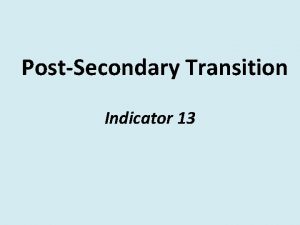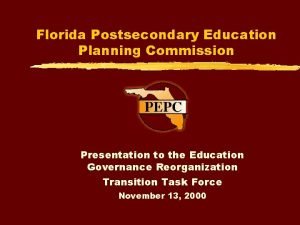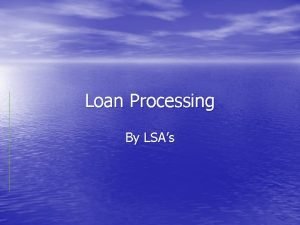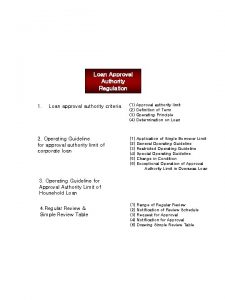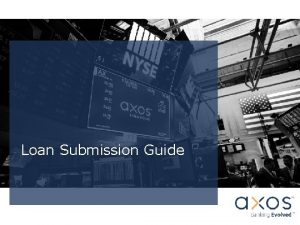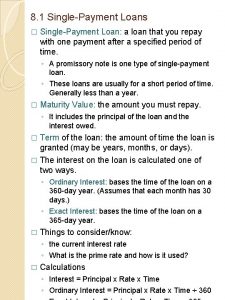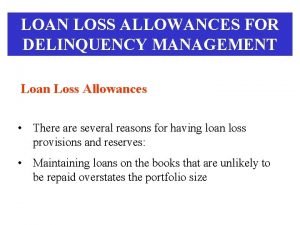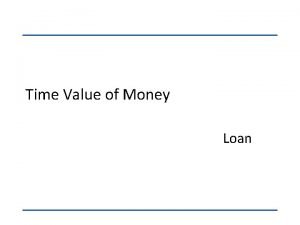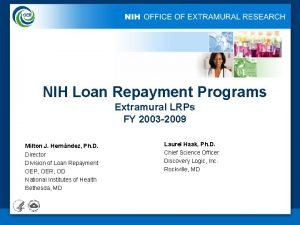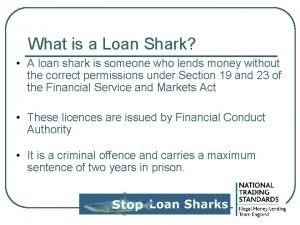Alaska Commission on Postsecondary Education Alaska Student Loan


























- Slides: 26

Alaska Commission on Postsecondary Education Alaska Student Loan Corporation Senate Finance Education Subcommittee February 28, 2013

Briefing Information Areas v Organizational overview v Agency Timeline v Programs to meet mission v Additional Q&A Alaska Commission on Postsecondary Education Page 1

Mission-related Programs and Services v Financial aid for college and career training v Advocacy and support for postsecondary participation in Alaska v Programs creating early awareness of the importance of preparing for success in higher education and career training v Education planning tools and resources v Education consumer protection through institutional authorization v Research and analysis of Alaska education trends and outcomes Alaska Commission on Postsecondary Education Page 2

Organizational Structure Partner entities • ACPE develops and delivers higher education access and support services • ASLC underwrites the costs of mission-related services • SOA directly funds WWAMI/scholarships/grants • Federal funds support peer mentor program/research resource development 14 -member ACPE with representation from: • UA Board of Regents (2) (Pat Jorgensen, Jo Heckman) • Private higher education (1) (Sue Linford) • Proprietary postsecondary education (1) (Milton Byrd) • State Senate (1) (vacant) • State House of Representatives (1) (Tammie Wilson) • General Public (4) (Becky Huggins, Jim Johnsen, Randy Weaver, Wirkus) • Student (1) (Andrew Mc. Connell) • Alaska Workforce Investment Board (1) (vacant) • Community College (1) (Sharon Gherman) • EED (1) (Jim Merriner) Alaska Commission on Postsecondary Education Page 3

Organizational Structure Five-member ASLC Board v Commissioner of Administration; Deputy Commissioner v v v Mike Barnhill, delegate Commissioner of Commerce, Community and Economic Development; Division of Economic Development Director Lorene Palmer, delegate Commissioner of Revenue; Deputy Commissioner Angela Rodell, delegate Two ACPE members appointed by the Governor; Lydia Wirkus and Randy Weaver Corporation responsibilities: • • Generate program funding by issuing tax exempt bonds backed by the loan assets Oversee investments, trusts and indentures; set loan interest rates and benefits Alaska Commission on Postsecondary Education Page 4

Organizational Structure Commission responsibilities: • • • Promulgation of authorization and financial aid program regulations Approve Alaska postsecondary education institution operations Represent and serve as liaisons with stakeholders Inform staff work/activities relative to issues of access, retention, completion and postsecondary education alignment with workforce needs Hire and oversee Executive Director performance Agency exists within the Executive Branch • • • Programs and services are subject to approval by the administration ACPE staff are part of fully exempt service ACPE resides within EED for budget organization purposes but does not report to either the Commissioner nor state board Alaska Commission on Postsecondary Education Page 5

Organizational Chart Alaska Commission on Postsecondary Education Page 6

Agency History v 1968 State of Alaska (State) education loan program is created; State directly funds loans. v 1974 ACPE established to administer State’s education loan and financial aid programs and regulate postsecondary institutions in Alaska. v 1987 With oil prices at historic lows, ASLC is established to finance Alaska education loans. v 1988 ACPE is designated as ASLC’s loan servicer. v 1992 Due to continued annual budget shortfalls, general support funding for ACPE ends. v 1995 Legislature approves changes to stem loan program losses and make program selfsustaining. v 2001 State legislation creates a new suite of education loan products; participation in the FFELP is authorized; and ASLC pays a return to the State. v 2002 ACPE begins originating FFELP Stafford and PLUS loans under the Alask. Advantage program; Outreach and Early Awareness unit is established. v 2003 I’m Going to College annual event launched for fifth and sixth graders. v 2005 First statewide Alaska College Goal Sunday event is held to assist Alaskans with completion of the Free Application for Federal Student Aid; legislation passed in 2004 is implemented as the Alask. Advantage Education Grant (AEG) to leverage federal grant funds. Alaska Commission on Postsecondary Education Page 7

Agency History v 2007 The first I Know I Can events encourage 2 nd graders to plan for education and careers beyond high school. v 2009 ACPE receives Alaska’s federal College Access Challenge Grant (CACG) to increase postsecondary education participation of low income students; Alaska College & Career Advising Corp places near-peer advisors in participating Alaska high schools. v 2010 Federal law expands Direct Loans ending FFELP as of July 1, 2010; ACPE continues to service approximately $163 million in FFELP loans. v 2010 Alaska Merit Scholarship enacted into law by the legislature creating Alaska’s first statewide scholarship. v 2011 Alaska’s high school graduating class of 2011 is the first to qualify for the new scholarship. v 2012 Legislature renames scholarship Alaska Performance Scholarship (APS) and creates the Alaska Higher Education Investment Fund as a sustainable source of APS and AEG funding. HEIF capitalized with $400+ million. v 2012 Alaska receives a three-year federal grant to link current K 12/postsecondary/labor data across sectors by creating a P-20 W Statewide Longitudinal Data System (SLDS). SLDS purpose is to deliver outcomes information to Alaska stakeholders to assess, evaluate and improve the State’s education and career development pipeline. Alaska Commission on Postsecondary Education Page 8

Alask. Advantage Loan Programs Federal Family Education Loan Program (discontinued) v ASLC FFELP lender from 2002— 2010 v ACPE currently servicing approximately $163 million in FFELs Alaska Supplemental Education Loan Program v Current iteration of state’s alternative education loan, as established in 2002 and most recently amended in 2009 v 2002 -2008 – credit criteria was less stringent and required an absence of derogatory credit history or credit-worthy cosigner v ACPE currently servicing approximately $437 million in ASELs Alaska Commission on Postsecondary Education Page 9

Alask. Advantage Loan Programs Alaska Family Education Loan Program v A state alternative to the federal PLUS loan permits family members to borrower to assist in covering the student’s educational costs v Currently offered at 7. 2% interest, 0. 7% below the PLUS rate v Similar credit writing standards in that it requires an absence of adverse credit history In FY 12 total loan volume – $7. 8 million Alaska Commission on Postsecondary Education Page 10

Alask. Advantage Loan Program Underwriting ASEL Current Underwriting Standards v Applicants must have a 680 FICO score or higher, or have a cosigner who meets the 680 FICO requirement v Applicants must not be delinquent or have ever defaulted on a prior student loan v 35% of borrower applicants meet credit criteria v 94% of cosigner applicants meet credit criteria v 61% of all applicants (student/cosigner) meet credit criteria Alaska Commission on Postsecondary Education Page 11

ACPE – Loan Servicing v ACPE originates, holds and internally services all ASLC loans on HELMS (Higher Education Loan Management System, by 5280 Solutions) v System upgrades and ongoing maintenance ensure compliance with all applicable federal lending requirements v Standard lending activities: • Application and origination • Loan forbearance or deferment • Payment processing • Loan repayment support and debt management counseling • Default aversion activities • Collection enforcement and activities • Business continuance planning v Ongoing internal process analysis on all service processes has assisted in achieving a culture of quality control and improvement Alaska Commission on Postsecondary Education Page 12

ACPE – Due Diligence/Collections v Mitigating loss risk through: • • Credit review Cosigner requirements Institutional default rate management Origination fee collected on alternative loan v Robust administrative collection authority (borrower and cosigner): i i i Permanent Fund Dividend (PFD) garnishment ($88. 4 million since FY 98) Administrative lien Administrative wage garnishment ($12 million since FY 01) Status reporting to national credit bureaus Litigation, including filing of court judgments Authority to deny occupational or professional license renewals v Skiptrace tools and resources: • • Access to mine State databases: Labor, PFD, vehicle licensing, Fish and Game licensing, etc. Industry standard resources: Experian and Accurint-type search engines Alaska Commission on Postsecondary Education Page 13

Alaska Financial Aid and Access Programs Student Exchange and Specialized Loan Programs v WICHE undergraduate, graduate and professional student exchange programs v FY 12 1, 496 AK WUE participants saved $12. 2 million in tuition costs v WWAMI Graduate Medical Education Program (ACPE services as the fiscal agent, passing these GF dollars to the University of Washington School of Medicine) v Winn Brindle Memorial Education Loan (administer partially dischargeable loans funded by fisheries-related businesses) v Teacher Education Loan Alaska Commission on Postsecondary Education Page 14

Financial Aid Programs—Alaska Performance Scholarship v 2, 322 eligible grads from 2011 class v $2, 983, 042 awarded to 953 students v 2, 175 eligible grads from 2012 class v $5, 710, 000 (thru January 2013) awarded to 1, 721 students (812 from 2012 class) Alaska Commission on Postsecondary Education Page 15

APS Award Levels Alaska Commission on Postsecondary Education Page 16

Using APS Funding Upon high school graduations have six-years window to use four years (eight semesters/twelve quarters) of APS funding. Can go straight through college… Year 1 Year 2 Year 3 Year 4 Funded Year 5 Year 6 I’m a graduate ! Or take up to 6 years to use 4 years of funding, Year 1 Volunteer work Year 2 Year 3 Year 4 Year 5 Year 6 Travel Funded as long as continues to meet eligibility requirements. Alaska Commission on Postsecondary Education Page 17

Continuing Eligibility Criteria v During the 1 st (freshman) year of college: v complete 24 semester credits or equivalent for full-time students v achieve a cumulative GPA of at least 2. 0 on a 4. 0 scale v During subsequent (sophomore, junior, senior) years: v complete 30 semester credits or equivalent for full-time students v achieve and maintain a cumulative GPA of at least 2. 5 on a 4. 0 scale v As a graduate student: v achieve and maintain a cumulative GPA of at least 2. 5 on a 4. 0 scale Alaska Commission on Postsecondary Education Page 18

APS. alaska. gov and Alaska Student Aid Portal (ASAP) Alaska Commission on Postsecondary Education Page 19

Financial Aid Programs—Alask. Advantage Education Grants v $2, 877, 237 awarded in FY 12 to 2, 532 students v $3, 991, 000 awarded in FY 13 (thru January, 2013) to 2, 532 students AEGs are need-based grants ranging from a $500 to $3, 000* *Basic grant maximum is $1, 500/year. Priority awards of up to $3, 000/year are available to students in programs of study in certain workforce shortage areas: Allied Health, Process Industries, Protective and Social Service, and Education. Priority awards are also available to otherwise eligible students who can demonstrate through a qualifying ACT or SAT score or through APS eligibility that they participated in a secondary education program of study that is a predictor of postsecondary education success. Alaska Commission on Postsecondary Education Page 20

Outreach and Early Awareness Programs and services to increase awareness of benefits of higher education and pathways to those benefits Age-based sequenced outreach coordinated with UA efforts to ensure no duplication of effort or focus • • • I Know I Can— 2 nd grade (joint with UA) I’m Going to College— 5 th/6 th grade (joint with UA) College-themed classroom poster— 5 th thru 8 th grade What’s Your Story, Alaska careers newspaper—middle school Going to College in Alaska— 10 th/11 th grade College Week Live— 12 th grade (joint with UA) Community visits and presentations • • • College Goal Alaska is a statewide event in 35 communities in 2013 Active in 45 communities in FY 12, serving over 28, 000 Alaskans From FY 08 to FY 11, saw a 48% increase in Alaskans filing FAFSAs Alaska Commission on Postsecondary Education Page 21

Outreach and Early Awareness Programs v AKCIS and career planning (middle and high school/adult versions) • As Career Information System administrator for Alaska, ACPE makes this online career/interest exploration and planning tool available to over 314 schools in the state • In FY 12 users accessed AKCIS more than 175, 000 times • Over 93, 000 individual portfolios existed for Alaska users in FY 12 • Provided AKCIS training to over 1, 441 students, parents, counselors and job centers staff • Includes middle school and high school/adult versions v APS/AEG and Alaska Student Aid Portal (ASAP) promotion • Statewide, multi-agency communications campaign using technology-based solutions to raise awareness and knowledge about APS and AEG • APS progress monitoring tools provided to high schools • APS listserv, ASAP, APS. alaska. gov, and teleconferences/webinars provide critical program information to the public Alaska Commission on Postsecondary Education Page 22

Outreach and Early Awareness Programs v Alaska’s College Access Challenge Grant recipient • Alaska Career & College Advising Corps places near-peer mentors in high schools populated with high percentages of low-income students w/o college going traditions in the family • Early outcomes reporting shows, for those high schools (Bartlett, Service, Bethel Regional, Lathrop, North Pole, Kodiak, Skyview and Nikiski) with embedded mentors, increases in students: o Expressing interest in accessing postsecondary education o Taking pre-college academic readiness assessments o Filing a FAFSA, and o Applying and being admitted to a college, university or postsecondary program • Focus now is on: o Developing scalable, sustainable model for broader service delivery o Ensuring capacity to collect outcomes data re: program impacts Alaska Commission on Postsecondary Education Page 23

Institutional Authorization v Components of this function include: • Approval of postsecondary education institutions and programs operating in Alaska • Investigation of student complaints • Audit of institutions administering Commission financial aid programs • Supervision of institutional closures and related student academic records retention • Liaison with accrediting bodies and USDOE Alaska Commission on Postsecondary Education Page 24

Research and Analysis Activities/Services v ACPE’s newest service area. Goals include: • Become a provider of and resource for research and analysis related to Alaska’s policies and practices relating to P-20 education and workforce training outcomes • Development feedback capacity for Alaska’s P-12 education data system by efficiently and systemically linking it to postsecondary, workforce, and other social outcomes data • Enable Alaska’s policy makers to inform their work with Alaskaspecific data and enable education and workforce administrators to identify where/how valuable state resources can best be utilized • Provide a mechanism for increased accountability for the outcomes related to the investment of private, state, and federal dollars Alaska Commission on Postsecondary Education Page 25
 Alaska student loans
Alaska student loans Arizona commission for postsecondary education
Arizona commission for postsecondary education Postsecondary education readiness test
Postsecondary education readiness test Postsecondary education options
Postsecondary education options Main defects of existing curriculum
Main defects of existing curriculum Alaska commission on aging
Alaska commission on aging Mypath student loan
Mypath student loan Student finance wales ema
Student finance wales ema Nslsc login online
Nslsc login online Hrsa student loan forgiveness
Hrsa student loan forgiveness Saf student loans
Saf student loans Slac student loan
Slac student loan What is a graduated commission
What is a graduated commission Kothari commission
Kothari commission Gender equality kothari commission has recommended
Gender equality kothari commission has recommended Financial literacy and education commission
Financial literacy and education commission Were you at the beach last weekend
Were you at the beach last weekend What did you do in london last weekend
What did you do in london last weekend National student clearinghouse student tracker
National student clearinghouse student tracker Class maths student student1 class student string name
Class maths student student1 class student string name National student clearinghouse student tracker
National student clearinghouse student tracker Freckle.student.com
Freckle.student.com Hi teacher good morning
Hi teacher good morning Sls moe
Sls moe Http //learn.education 2020.com/student
Http //learn.education 2020.com/student Sesis help desk
Sesis help desk Special education information system
Special education information system
